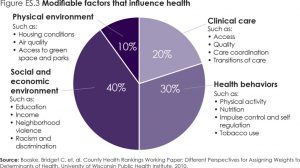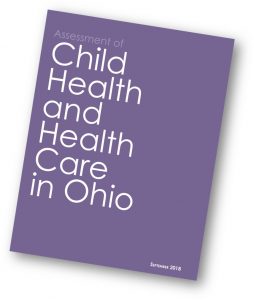Ohio’s Children’s Hospitals Call on Ohio Leaders to Come Together to Address Three Key Challenges Facing Ohio Children
New report from HPIO – the first of its kind in the country – indicates gaps between high quality care and health metrics for Ohio children, recommends policy goals
COLUMBUS, Ohio – Despite the fact that Ohio has access to some of the most outstanding children’s hospitals and network of pediatricians in the country, Ohio ranked in the bottom half of states on 65 percent of national child health metrics, according to a report from The Health Policy Institute of Ohio (HPIO) released today at the request of the Ohio Children’s Hospital Association (OCHA).
This disturbing metric is attributed to the fact that just 20 percent of child health is impacted by actual clinical health care (access, quality, care coordination and transition), while 80 percent of child health is impacted by non-health care factors, including:
- Health behaviors: physical activity, nutrition, impulse control and self-regulation and tobacco use
- Physical environment: housing, air quality, access to parks/green space
- Social/economic environment: education, income, neighborhood safety and racism/discrimination
 The Assessment of Child Health and Health Care in Ohio, the first of its kind in the country, was commissioned by OCHA to provide a single, comprehensive, objective assessment of the state of child health in Ohio, contributing factors and recommended solutions. HPIO analyzed national and statewide data and worked with a multi-sector advisory committee of pediatric clinicians, experts and advocates to develop this assessment.
The Assessment of Child Health and Health Care in Ohio, the first of its kind in the country, was commissioned by OCHA to provide a single, comprehensive, objective assessment of the state of child health in Ohio, contributing factors and recommended solutions. HPIO analyzed national and statewide data and worked with a multi-sector advisory committee of pediatric clinicians, experts and advocates to develop this assessment.
“While it would have been easy – and, let’s face it, comfortable – for children’s hospitals to tout our national leadership on things like patient safety and child abuse prevention, among other things and all of the amazing innovations that our institutions have created and implemented, what we wanted was the brutal, blunt truth about the state of child health in our state. And that’s what we got,” said Debbie Feldman, Vice Chair, OCHA and President and CEO, Dayton Children’s Hospital. Feldman led a session with approximately 700 attendees to unveil the report at today’s Vote for Ohio Kids forum, held in Columbus, Ohio. “There are many well-intended people and organizations trying to make an impact individually in Ohio, but what we really need are statewide strategies,” said Feldman.
The report specifically notes that Ohio needs a comprehensive approach to address child health, focusing on three child health policy priority areas: Mental health and addiction, chronic disease, and maternal and infant health.
“Ohio’s children’s hospitals are drawing a line in the sand on these three issues and are ready to lead the charge to identify and implement opportunities for improvement, but this requires public and private sector collaboration from a wide variety of entities including policymakers, providers of healthcare services, insurers, schools, community-based organizations and the support of parents, caregivers and families,” said Nick Lashutka, President and CEO, OCHA. “We stand ready to work with Ohio’s next governor to develop and implement comprehensive policies to address these issues,” said Lashutka.
Additionally, the report notes four specific policy goals for improved child health and wellbeing in Ohio that can only be achieved when Ohio leaders, child advocates and health care providers work together:
- Eliminate gaps in child outcomes. All young Ohioans have the opportunity to make healthy choices and achieve optimal health, regardless of their race/ethnicity, family income, where they live or other social, economic or demographic factors.
- Promote economic vitality for Ohio families. All families in Ohio have the opportunity to achieve financial and housing stability.
- Evaluate Ohio’s progress toward improving child health. Ohio makes strong investments in data collection, research and evaluation of strategies to improve the health of young Ohioans.
- Pay for child health and wellbeing. Payments to providers incentivize improved child health and wellbeing, are based on population-level outcomes, address the modifiable factors of health and are stable, predictable and adequate.
The full report and executive summary is available on the HPIO website (http://bit.ly/2PBJrJ4)
The six members of the Ohio Children’s Hospital Association – Akron Children’s Hospital, Cincinnati Children’s Hospital Medical Center, UH/Rainbow Babies & Children’s Hospital, Nationwide Children’s Hospital, Dayton Children’s and ProMedica Russell J. Ebeid Children’s Hospital – work together to save, protect and enhance the lives of all Ohio children by providing the highest quality of care regardless of a family’s ability to pay. More information is available at www.ohiochildrenshospitals.org; on Facebook: https://www.facebook.com/OhioChildrensHospitals; or on Twitter: https://twitter.com/OhioChildHosp
###
